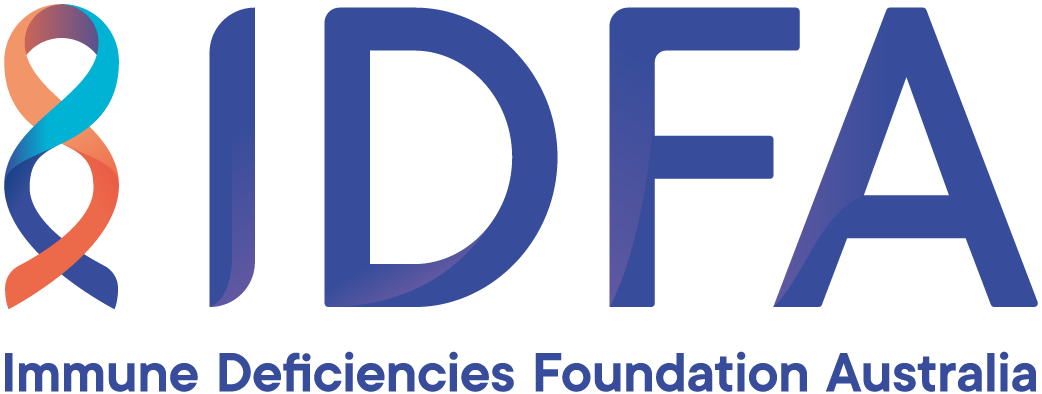Kelly is the mother to two beautiful children, one of which has a diagnosis of an immunodeficiency. Kelly’s second child was born only 18 months after her first, and from birth, she could tell something was not quite right. She noticed early on that their child had a temperature everyday of their first 18 months of life, and continually visited the doctor to figure out what was going on. From 6 to 18 months, their child underwent over 50 consecutive courses of antibiotics and was frequently ill with conditions like croup.
With a background as a health professional, Kelly knew being this sick was not ‘normal’ for a young child. Finally, at 18 months, a paediatrician determined this was not normal, and decided to conduct immune testes, which revealed low immunoglobulin, and the child was referred to the children’s hospital in Sydney. From testing and various appointments, Kelly finally had a diagnosis for her child, Common Variable Immune Deficiency (CVID), at age two.
After diagnosis, the road has had many ups and downs for the family. These days, treatment for her child is monthly IVIg (in hospital), after being on SCIg for 11 years. Both treatments have challenges, however the family did find SCIg was more effective on the child. With the current IVIg treatment, there are some side effects that impact their quality of life including myalgia, headaches and UTIs.
With the setbacks from treatment, Kelly and her child do many things to help their day to day living. These include adhering to a balanced diet, being outside as much as possible, and carrying on with their lives the way most people do. Of course, they have strategies in place such as wearing a mask in confined spaces such as school. Kelly’s child is now 13 years old and is very aware of their surroundings, and environment, and employs strategies to stay well. One of these was to not catch the school bus as it’s a very confined environment with lots of (potentially sick) children.
Kelly’s child knows their limits, and to live life to the fullest, ensures they take adequate rest, especially when it comes to social situations, they know when their social battery is empty. They don’t shy away from things, but sometimes works out a different way to do things. For example, the children might want to go to the movies, but Kelly would prefer not to go into the theatre (enclosed space), so the kids can have movies at home. Often, they will have other kids over at their place, to minimise the risk (when possible) of large crowds.
Even Kelly’s other child has started making conscious decisions to protect their sibling. One instance was when there was a school excursion they didn’t want to go in case they brought home sickness that impacted their sibling. The entire family makes choices to reduce risk, but still work hard to continue with their lives as much as possible.
Support from the Clinical Nurse Consultants (CNC) at Sydney Children’s Hospital has been instrumental in helping the family get to where they are today. Advocating for their needs and finding the right resources has been crucial. When school started around age five, Kelly discovered a book for children with immunodeficiencies (from Geraldine), which became a cherished resource. The book was read multiple times and provided comfort, especially the realisation that they weren’t alone knowing that others in Wollongong shared similar experiences was incredibly reassuring.
Connecting with other people, especially adults who have walked this path, has been a significant help. It’s important for children to see a future that they can relate to, even if they feel socially anxious. Hearing the stories of others who have faced similar challenges makes a world of difference.
One thing Kelly would recommend to families in the early stages of their journey is to connect with another family who has already been through it. Having someone to chat with and debrief can make a huge difference in understanding and coping with the challenges ahead.
Starting SCIg (subcutaneous immunoglobulin) treatment was a game-changer for Kelly’s family. The improvement in her child’s health was clear—they haven’t been ill for 11 years, and it dramatically enhanced their quality of life. It’s an amazing treatment that turned them into a completely different child, full of energy and health. Kelly’s advice is not to fear the change; it may seem daunting, but it can lead to a much better quality of life. It’s not as overwhelming as it might initially appear and having medical treatment at home can significantly improve early years.
Kelly learned the importance of planning their lives around her child’s treatment, especially when it comes to holidays. For example, during a trip to Hawaii, her child got sick on day 6 of 10 because they didn’t have their treatment, which taught Kelly to prioritise medical needs, even on vacation. This also means sometimes adjusting plans, like not going overseas for extended periods, because family and treatment come first.
At school, Kelly’s child has often been asked by teachers about their medical condition, CVID. These conversations are common, and it’s essential to provide clear information. Kelly suggests using an infographic explaining that the child just needs a little extra protection. It’s important to communicate that this is a serious condition, and here’s how to handle it. For instance, teachers should inform Kelly if there are kids with chickenpox, measles, or other infections, so the necessary precautions or surveillance can be taken.
Kelly has learnt to trust her instinct as a carer and is very proud of her child that is impacted by an immune deficiency.

